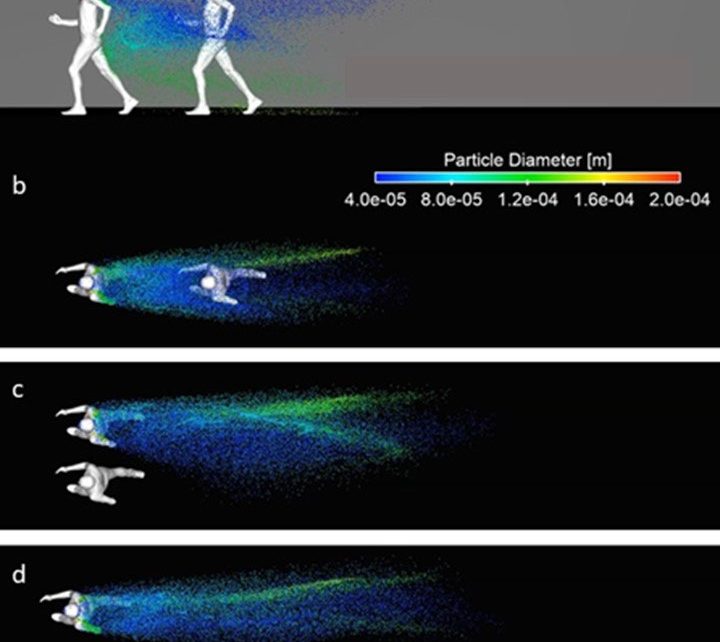His team concluded that cyclists and runners have to stay much farther than 6 feet from a runner or rider in front of them to avoid inhaling droplets or having them land on their bodies. He calculated safe distances for each sport: That 65 feet is needed when riding a bike at 18 miles per hour, 33 feet while running at a 6:44 minutes-per-mile pace, or 16 feet while walking at a normal pace. “By that time, the droplets will have moved down to the ground and you won’t get them in your face,” says Blocken. What about riding or jogging side by side? “It’s no problem unless you turn your head and cough in their direction,” Blocken added.
The wind tunnel tests concluded that the zone of potential danger falls in a narrow slipstream behind runners and cyclists, instead of forming a wide V-shaped cone. In theory, Blocken says, this means that runners or cyclists can limit their exposure even more by staggering their position to avoid that slipstream.
The root of the debate over Blocken’s study isn’t whether his team correctly gauged where the droplets might fall; it’s that it’s led to such intense speculation over how likely these particles are to make anyone sick.
Right now, we know that the coronavirus is passed from person to person when someone coughs or sneezes, or when the virus lands on a surface and is touched by a person who then touches their face. The amount of time the viruses can survive outside the body depends on the surface, according to the National Institutes of Health. It’s also not clear what amount or density of viral particles it takes to infect someone, although that’s a question that scientists really want to answer. They know that the density of particles, or viral load, plays a big role; crowded indoor spaces carry a bigger viral load than open outdoor spaces. Virologists also note that the time of exposure is important—a brief hello to a neighbor on the sidewalk poses less of a risk than sitting next to your friend at an outdoor café for a few beers.
But so far there are no published studies of the spread of the novel coronavirus from one person to another in outdoor settings. One recent study of 318 outbreaks of three or more Covid-19 patients found all but one transmission occurred indoors—but as with many studies being conducted right now, that report was published as a pre-print in MedRxiv by a team of researchers at Hong Kong University and Southeast University in Nanjing, China, which means it has not yet been peer-reviewed.
Linsey Marr, an expert in airborne transmission of viral diseases and a professor of civil engineering at Virginia Tech, says the issue of whether people can become infected from cyclists or runners is still undecided. “We need to keep in mind, though, that we don’t yet know what size particles released by an infected person actually contain virus and whether that virus is ‘alive,’ or can still infect others,” Marr wrote in an email to WIRED.
She agreed with Blocken’s advice to walkers and runners to allow for greater spacing if traveling right in front of or right behind another person. However, she notes that the study assumed no wind. “Basically, if you’re directly upwind or downwind of others,” Marr wrote “allow for more space.”
Marr wrote that she wasn’t upset that the researchers decided to publicize their work through the media instead of through the traditional route of submitting the study to a peer-reviewed journal. “Given the situation we’re in, I think it’s fair that the researchers shared the results because they could be immediately useful,” she wrote.
A half dozen other virologists contacted by WIRED declined to comment on Bracken’s study, saying they were busy reviewing papers or conducting their own research, or had responded to reporters’ requests last week. But as many researchers in this field had previously told WIRED’s Roxanne Khamsi, there’s still a vigorous debate among researchers over how likely the virus is to spread through air. Some argue that if it’s spread through larger blobs or “droplets” that are coughed, sneezed or exhaled, it will fall quickly to the ground; others argue that if it is spread through finer “aerosols” it can linger aloft for much longer, creating a higher infection risk. And some say there’s no clear division between the two categories, anyway.




